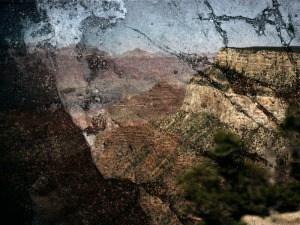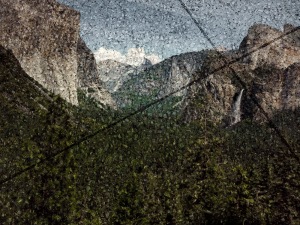I came across some stunning photographs whilst flicking thru the latest National Geographic last night. I immediately recognised the Merced River in Yosemite in one of them. Then Half Dome in another. Then the Grand Tetons. The list continued.
As I glanced at the images, I initially thought they were heavily photoshopped with scratching and massive contrast shifts. I then realised that the images were actually projected onto the ground, and the scratches were infact twigs and leaves, and the contrast created by different coloured pebbles and stones and rocks. Artist Abelardo Morell explains his technique:
I worked on designing a light proof tent which can project views of the surrounding landscape, via periscope type optics, onto the surface of the ground inside the tent. Inside this space I photograph the sandwich of these two outdoor realities meeting on the ground. Depending on the quality of the surface, these views can take on a variety of painterly effects. The added use of digital technology on my camera lets me record visual moments in a much shorter time frame– for instance I can now get clouds and people to show up in some of the photographs.
This way of observing the landscape with specially equipped tents was practiced by some artists in the 19th century in order to trace on paper what they saw in the landscape. Interestingly, this approach to picturing the land was done even before the invention of photography.
I read the insightful short article attached by Tom O’Neill. Coincidently to my earlier post this week, and echoing my submission to the Victorian Government regarding National Park camping fees, he repeated the esteem the National Parks hold for all Americans.
…they and countless other photographers in between have celebrated the glories of one of America’s finest creations—the National Park System.
The exquisite images are a true reflection of the stature that Americans hold their National Parks in.
Here is the Tom O’Neill article Visions on Earth:
To reach Bridalveil Fall in Yosemite Valley, photographer Carleton Watkins traveled heavy. The year was 1861, not long after the frenzy of the California gold rush, and 31-year-old Watkins tackled the Sierra Nevada like a prospector expecting riches. He led a procession of mules, their backs loaded with heavy glass photographic plates and jars of chemicals. After a 50-mile tramp, Watkins staked his claim on a patch of ground in full view of the spectacular waterfall. He set his camera on a tripod and waited for the good light.
One hundred fifty years later, it was Abelardo Morell’s turn. “I didn’t have that hard a time getting there,” the 65-year-old says wryly. In Yosemite National Park the Cuban-born Morell pulled off a paved road and walked a short way to the bank of the Merced River. Close to where Watkins stood, he pitched a domed tent with a periscope on top. Morell positioned his digital camera inside and waited for the good light.
Separated by a chasm of decades and technologies, Watkins and Morell were identical in their goal: to make photographs that would open eyes to the majesty and profundity of the western landscape. In so doing, they and countless other photographers in between have celebrated the glories of one of America’s finest creations—the National Park System.
Watkins and his fellow pioneers in wilderness photography—Timothy O’Sullivan, Eadweard Muybridge, William Henry Jackson—took advantage of a new development in photography, the use of large, transportable, chemical-coated glass plates to create exposures. Up to this time photographers were pretty much confined to studios, using small, sensitized copper plates to make portraits. Wet-glass technology, with its shorter exposures and less fragile equipment, freed photographers to work outdoors.
Compared with his 19th-century pacesetters, Morell is practically an antiquarian, adapting one of the earliest known viewing mechanisms—the camera obscura. Since the 1990s, Morell, recently retired as a professor of photography at the Massachusetts College of Art and Design, has been following the most basic of optic principles: focusing light through a small opening onto a dark surface. At first he used rooms as his reflecting plane, projecting outside images of streets, skyscrapers, bridges, and fields onto dark walls and floors and capturing the surreal double vision on his camera. Now Morell himself has gone outdoors, using the ground, rough and intimate, as his backdrop.
With two aims in mind—paying homage to the early photographers and challenging people today to reimagine postcard views—Morell has been setting up his camera obscura rig in national parks across the West. And so the familiar scene of Bridalveil Fall appears, in Morell’s vision, as a dreamlike vista painted on a canvas of pine needles, grass, and weeds. Old Faithful gushes beneath a scrim of gravel and twigs, as if glimpsed behind frosted glass. A galaxy of pebbles glows around a sandstone arch.
In making these lovely, haunting images, Morell can’t claim the dramatic results of his predecessors, whose photographs catalyzed the founding of America’s first national parks. Morell’s accomplishment is subtler, but still daring. He looks at some of our most treasured natural wonders and lets us see them in unexpected ways, the sublime brought down to earth.









